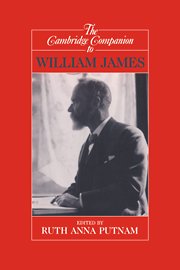Book contents
- Frontmatter
- Introduction
- 1 Pragmatism and introspective psychology
- 2 Consciousness as a pragmatist views it
- 3 John Dewey's naturalization of William James
- 4 James, Clifford, and the scientific conscience
- 5 Religious faith, intellectual responsibility, and romance
- 6 The breathtaking intimacy of the material world
- 7 James, aboutness, and his British critics
- 8 Logical principles and philosophical attitudes
- 9 James's theory of truth
- 10 The James/Royce dispute and the development of Jarnests "solution"
- 11 William James on religious experience
- 12 Interpreting the universe after a social analogy
- 13 Moral philosophy and the development of morality
- 14 Some of life's ideals
- 15 “A shelter of the mind”
- 16 The influence of William James on American culture
- 17 Pragmatism, politics, and the corridor
- 18 James and the Kantian tradition
- Bibliography
- Index
6 - The breathtaking intimacy of the material world
William James's last thoughts
Published online by Cambridge University Press: 28 May 2006
- Frontmatter
- Introduction
- 1 Pragmatism and introspective psychology
- 2 Consciousness as a pragmatist views it
- 3 John Dewey's naturalization of William James
- 4 James, Clifford, and the scientific conscience
- 5 Religious faith, intellectual responsibility, and romance
- 6 The breathtaking intimacy of the material world
- 7 James, aboutness, and his British critics
- 8 Logical principles and philosophical attitudes
- 9 James's theory of truth
- 10 The James/Royce dispute and the development of Jarnests "solution"
- 11 William James on religious experience
- 12 Interpreting the universe after a social analogy
- 13 Moral philosophy and the development of morality
- 14 Some of life's ideals
- 15 “A shelter of the mind”
- 16 The influence of William James on American culture
- 17 Pragmatism, politics, and the corridor
- 18 James and the Kantian tradition
- Bibliography
- Index
Summary
When William James began to write in the nineteenth century, technological, industrial, and political revolutions had destroyed ways of life evolved over centuries of adaptation to nature. James belongs with those who tried to reweave a coherent world in thought and experience. At the end of his life, he evolved what he called a “comminuted” - pulverized - “Identitätsphilosophie.” Without grasping this world-view, there is no way to know what James was up to, for example, his pragmatic theory of truth.
The view that spirit (or mind) and nature (or matter) are identical was advanced most famously by Schelling very early in the nineteenth century, with key concepts refined, disciplined, and constricted by Hegel a little later. Early on, James has little or nothing to say about Shelling, as if even acknowledging his existence were to give him too much credit. With regard to Hegel, he bristles with contempt. We will see how he inched over the decades toward the views he ridiculed. He tried to retain a vision of the individual's intimate inclusion in a whole, but a whole construed pluralistically. His method was a phenomenology divested of rationalistic presuppositions.
- Type
- Chapter
- Information
- The Cambridge Companion to William James , pp. 103 - 124Publisher: Cambridge University PressPrint publication year: 1997
- 7
- Cited by



